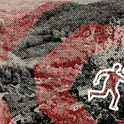Before Syrians had to flee, Iraqis fled. Before the Iraqis fled, Palestinians had to. A hundred years ago, Armenians were driven out of their Ottoman homelands by the young Turks. Waves of refugees have washed into Lebanon; many have stayed.
In May, in the Burj Hammud neighbourhood of Beirut where the Armenians settled, Armenian flags fluttered from every building and graffiti stencils of a gobbling turkey head were sprayed on the walls. It is a century since a genocide that has not been forgotten—nor acknowledged by its perpetrator. My friend Aline Kamakian grew up in a proudly Armenian household during Lebanon’s civil war. Her grandmother was nine when she escaped, rescued by a French ship from Musa Dagh, a region where the Armenians bravely resisted forced deportation. During Aline’s childhood, “Everything revolved around food. At breakfast we discussed what we would have for lunch. At lunch it was ‘what’s for dinner?’ This was our culture.” Cooking, kitchen and hearth were touchstones: mothers, grandmothers and aunts were the guardians of their heritage.
“It was not a question of assimilation into Lebanese culture. It was survival. We had to protect our language, our culture, our identity. Food was the focus, meals where they could gather and remember and talk. It was about feeling and memory, about belonging, soul, nostalgia. Sometimes the smell of a certain dish would make my grandmother cry.”
It was Aline’s father’s dream to have a restaurant where he could serve his friends real Armenian food. Aline and her cousin Serge opened Mayrig in Beirut in 2003. It is a favourite of mine from when I lived there 10 years ago—here I first tasted sou boureg, a delicate cheese pie-lasagne made of layered dough and three kinds of cheese. It is “the most complex Armenian dish because it is time-consuming and detailed.” During the war between Israel and Hezbollah in 2006, I would come back from the bombed-out south to calming bowls of pastel-coloured ice creams flavoured rose, wild cherry, or marzipan; meghle (a rice pudding with cinnamon, carraway and anise); or ashtalieh (a pistacho milk dessert).
“Everything on our menu is basically the food that I ate at home growing up.” Aline explained as we sat on Mayrig’s terrace sharing a plate of delicate crispy tear-shaped rice kibbeh. To develop recipes and techniques for a restaurant kitchen she and her cousin Serge turned to their mothers and aunts. Though Mayrig has prospered and opened franchises in Dubai and Riyadh, but aunts Maryam and Azadouhie remain in charge.
One morning I watched Aunt Maryam overseeing six ladies making manti (tiny ravioli-dumplings) in their central kitchen in a mountain suburb outside Beirut. They rolled the dough, cut it into squares and pinched them around the meat filling to make little open boat-shaped parcels.
“They don’t have recipes,” Elie Merhi, Mayrig’s head chef, tells me; “they believe in their taste and touch.” He has learned their techniques, but admits his dishes don’t taste the same. A few years ago they bought a manti-making machine from Canada but only used it once. “You can’t get the texture and taste.” Aline says. “You can’t replace the love given by those women.”
Armenian food overlaps with that of Ottoman Turkey, Aleppo and the Levant—a cuisine of bright herb salads, kibbeh (many variations of lamb and vegetables encased in bulgur pastry), keufteh (pounded tartares of raw lamb or vegetables with bulgur and spices) and kebab. But it carries its own balance of flavour that veers between the tang of yoghurt, the muted sparkle of dried mint, the citrus twang of sumac, the agrodolce of pomegranate molasses and the delayed back-throat heat of the red paste made from Aleppo peppers cooked over open fires, pounded to a paste and then dried in the sun. The taste is bittersweet.
“I really learned about the differences between Armenian dishes from the different regions in what is now Turkey when I came to write our cookbook Armenia Cuisine,” Aline told me. She and Barbara travelled to Diyarbakir in Turkey in search of a pilau of rice, chicken and dried fruit baked inside a bread crust; to Musaler in Armenia for their harissa, a porridge-stew of dried wheat and fatty lamb simmered overnight; to Anjar in Lebanon for potato keufteh. The book is a testament to a lost terroir. They found only the culinary vestiges left by a long-gone population.
“The important thing about these trips was that I somehow cleansed myself. This baggage that I had been carrying around of being Armenian; we were told we must keep the traditions, that we had to fight for our memory, that it was so very important to protect and share our culture—this duty I had performed. The restaurant was the realisation of my father’s dream, but the book was about honouring every mother who had kept this tradition alive.”
Mayrig means “mother” in Armenian, and this restaurant adheres to the traditional. Aline and Serge opened a second Beirut restaurant called Batchig which means “kiss.” This is less formal, more of a bistro, and the cuisine is a mash-up with Lebanese food. When we live in a different country, whether as refugees or ordinary itinerants, we have to decide whether to protect our culture and heritage or start afresh and assimilate. Somewhere between a mother’s kitchen and a kiss, lies the promise of a new life. Wendell Steavenson is an Associate Editor of Prospect

Kibbeh, minced meat with bulgur or rice
Matters of taste: Armenia's culinary heritage
"Cooking, kitchen and hearth were touchstones: mothers, grandmothers and aunts were the guardians of their heritage"
June 15, 2016











